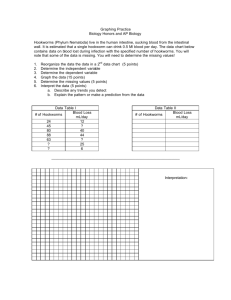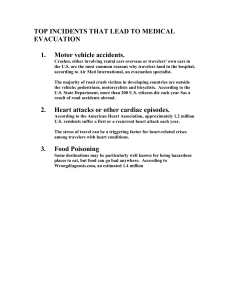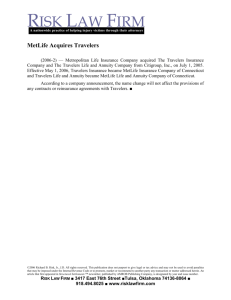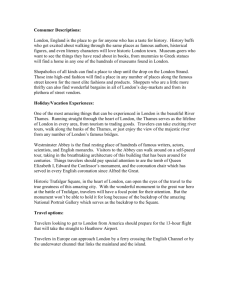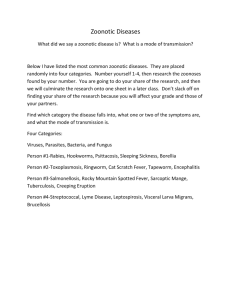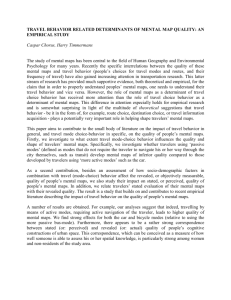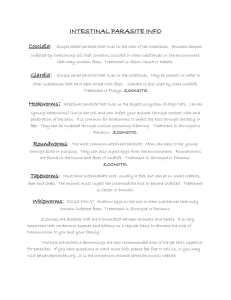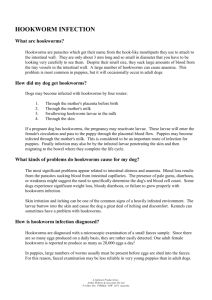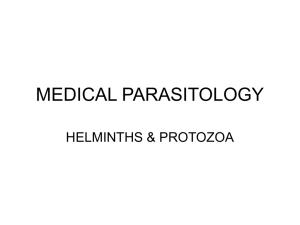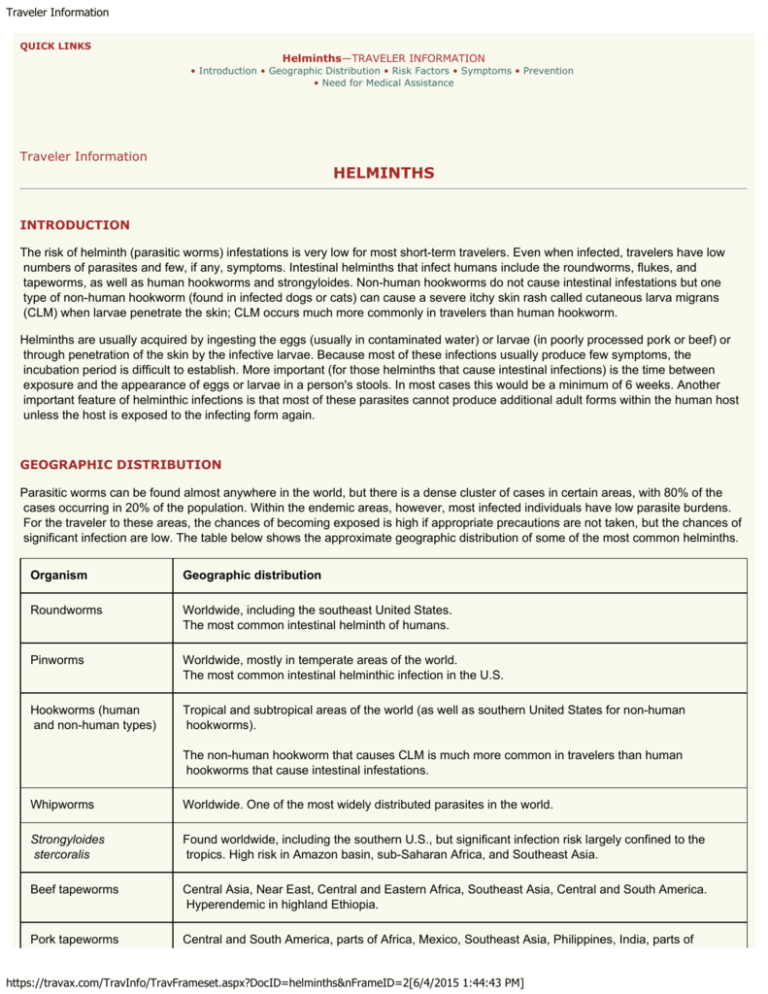
Traveler Information
QUICK LINKS
Helminths—TRAVELER INFORMATION
• Introduction • Geographic Distribution • Risk Factors • Symptoms • Prevention
• Need for Medical Assistance
Traveler Information
HELMINTHS
INTRODUCTION
The risk of helminth (parasitic worms) infestations is very low for most short-term travelers. Even when infected, travelers have low
numbers of parasites and few, if any, symptoms. Intestinal helminths that infect humans include the roundworms, flukes, and
tapeworms, as well as human hookworms and strongyloides. Non-human hookworms do not cause intestinal infestations but one
type of non-human hookworm (found in infected dogs or cats) can cause a severe itchy skin rash called cutaneous larva migrans
(CLM) when larvae penetrate the skin; CLM occurs much more commonly in travelers than human hookworm.
Helminths are usually acquired by ingesting the eggs (usually in contaminated water) or larvae (in poorly processed pork or beef) or
through penetration of the skin by the infective larvae. Because most of these infections usually produce few symptoms, the
incubation period is difficult to establish. More important (for those helminths that cause intestinal infections) is the time between
exposure and the appearance of eggs or larvae in a person's stools. In most cases this would be a minimum of 6 weeks. Another
important feature of helminthic infections is that most of these parasites cannot produce additional adult forms within the human host
unless the host is exposed to the infecting form again.
GEOGRAPHIC DISTRIBUTION
Parasitic worms can be found almost anywhere in the world, but there is a dense cluster of cases in certain areas, with 80% of the
cases occurring in 20% of the population. Within the endemic areas, however, most infected individuals have low parasite burdens.
For the traveler to these areas, the chances of becoming exposed is high if appropriate precautions are not taken, but the chances of
significant infection are low. The table below shows the approximate geographic distribution of some of the most common helminths.
Organism
Geographic distribution
Roundworms
Worldwide, including the southeast United States.
The most common intestinal helminth of humans.
Pinworms
Worldwide, mostly in temperate areas of the world.
The most common intestinal helminthic infection in the U.S.
Hookworms (human
and non-human types)
Tropical and subtropical areas of the world (as well as southern United States for non-human
hookworms).
The non-human hookworm that causes CLM is much more common in travelers than human
hookworms that cause intestinal infestations.
Whipworms
Worldwide. One of the most widely distributed parasites in the world.
Strongyloides
stercoralis
Found worldwide, including the southern U.S., but significant infection risk largely confined to the
tropics. High risk in Amazon basin, sub-Saharan Africa, and Southeast Asia.
Beef tapeworms
Central Asia, Near East, Central and Eastern Africa, Southeast Asia, Central and South America.
Hyperendemic in highland Ethiopia.
Pork tapeworms
Central and South America, parts of Africa, Mexico, Southeast Asia, Philippines, India, parts of
https://travax.com/TravInfo/TravFrameset.aspx?DocID=helminths&nFrameID=2[6/4/2015 1:44:43 PM]
Traveler Information
southern Europe.
RISK FACTORS
Travelers at highest risk for acquiring intestinal helminthic infections are those who are exposed to unsanitary conditions, particularly
water or food contaminated with human or animal waste. Some parasites, especially the soil-transmitted helminths, are more
common in jungle areas, thus increasing the risk for missionaries, bird watchers, eco-tourists, and other travelers who venture into
forested areas, often without easy access to safe food or water.
Travelers are at risk for acquiring strongyloides and hookworms (both non-human hookworms and human hookworms) when walking
barefoot or lying on moist sand or soil in endemic areas. The non-human hookworm that causes cutaneous larva migrans is a
particular risk when walking barefootalong the tide line of tropical and sub-tropical beaches where dogs run free and deposit feces on
the sand.
In general, expatriates and travelers who stay for prolonged periods of time in the endemic areas are more likely than short-term
travelers to develop clinically significant parasitic infections as a consequence of relaxation of precautionary measures and repeated
exposures over time.
SYMPTOMS
Symptoms are extremely varied depending on the organism and amount of parasites present. Most intestinal cases in travelers are
completely asymptomatic, although all the helminthic gastrointestinal infections can cause non-specific digestive symptoms, including
mild to moderate abdominal pain, diarrhea of varying intensities, and abdominal distention. Passage of large worms (3-20 inches in
length) that are thick and round is indicative of roundworm infection. Tapeworm segments are flat and rectangular. Others are not
commonly passed and are often too small to be visible to the naked eye.
Symptoms of cutaneous larva migrans include itchy, red lesions that may look serpentine or linear, appearing mostly typically on the
feet, lower legs, or between the toes, or anywhere the body or one's clothing comes in contact with the ground.
PREVENTION
The most important preventive strategy for intestinal helminths is to avoid consumption of unprocessed water, ice, raw vegetables,
fruits with skin that have not been thoroughly washed with clean water, and other food items processed in unsanitary conditions.
Avoid consumption of undercooked beef or pork, as well as salted, dried, or pickled meat-derived products.
To prevent Strongyloides infection and hookworms, including the type that causes cutaneous larva migrans, avoid walking barefoot or
lying on the sand, and avoid prolonged contact of exposed skin to soil, particularly in areas where fecal contamination of the soil is
likely.
NEED FOR MEDICAL ASSISTANCE
The risk of significant gastrointestinal helminthic infestation is very low for most short-term travelers, and post-travel screening and
treatment is generally not warranted for the typical recreational traveler. In general, stool examinations are considered only for those
travelers who have spent 6 months or more in a very high-risk environment. Some long-stay expatriates without access to diagnostic
facilities routinely self-treat every 6 months with albendazole or mebendazole.
Cutaneous larva migrans (CLM) is caused by non-human hookworms and is much more common in travelers than intestinal
hookworms; therefore travelers to areas with non-human hookworms should watch for signs of CLM: itchy rashes, spots, or lines on
the feet, legs, or body. Cutaneous larva migrans can be treated with a single dose of ivermectin.
Travax content represents decision-relevant, expert synthesis of real-time data reconciled with new and existing available advice from authoritative national and international
bodies. Recommendations may differ from those of individual countries' public health authorities.
© Shoreland, Inc. All rights reserved.
https://travax.com/TravInfo/TravFrameset.aspx?DocID=helminths&nFrameID=2[6/4/2015 1:44:43 PM]

